Entry Database : PDB / ID : 1qkuTitle WILD TYPE ESTROGEN NUCLEAR RECEPTOR LIGAND BINDING DOMAIN COMPLEXED WITH ESTRADIOL ESTRADIOL RECEPTOR Keywords / / / / / / / Function / homology Function Domain/homology Component
/ / / / / / / / / / / / / / / / / / / / / / / / / / / / / / / / / / / / / / / / / / / / / / / / / / / / / / / / / / / / / / / / / / / / / / / / / / / / / / / / / / / / / / / / / / / / / / / / / / / / / / / / / / / / / / / / / / / / / / / / / / / / / / / / / / / / / / Biological species HOMO SAPIENS (human)Method / / / Resolution : 3.2 Å Authors Ruff, M. / Gangloff, M. / Eiler, S. / Duclaud, S. / Wurtz, J.M. / Moras, D. Journal : J. Biol. Chem. / Year : 2001Title : Crystal structure of a mutant hERalpha ligand-binding domain reveals key structural features for the mechanism of partial agonism.Authors : Gangloff, M. / Ruff, M. / Eiler, S. / Duclaud, S. / Wurtz, J.M. / Moras, D. History Deposition Aug 5, 1999 Deposition site / Processing site Revision 1.0 Aug 18, 2000 Provider / Type Revision 1.1 May 8, 2011 Group Revision 1.2 Jul 13, 2011 Group Revision 1.3 Feb 28, 2018 Group / Source and taxonomy / Category / entity_src_genItem _citation.journal_abbrev / _citation.page_last ... _citation.journal_abbrev / _citation.page_last / _citation.pdbx_database_id_DOI / _citation.title / _entity_src_gen.pdbx_host_org_cell_line / _entity_src_gen.pdbx_host_org_ncbi_taxonomy_id / _entity_src_gen.pdbx_host_org_scientific_name Revision 1.4 May 8, 2024 Group Data collection / Database references ... Data collection / Database references / Derived calculations / Other Category chem_comp_atom / chem_comp_bond ... chem_comp_atom / chem_comp_bond / database_2 / pdbx_database_status / struct_site Item _database_2.pdbx_DOI / _database_2.pdbx_database_accession ... _database_2.pdbx_DOI / _database_2.pdbx_database_accession / _pdbx_database_status.status_code_sf / _struct_site.pdbx_auth_asym_id / _struct_site.pdbx_auth_comp_id / _struct_site.pdbx_auth_seq_id
Show all Show less
 Yorodumi
Yorodumi Open data
Open data Basic information
Basic information Components
Components Keywords
Keywords Function and homology information
Function and homology information HOMO SAPIENS (human)
HOMO SAPIENS (human) X-RAY DIFFRACTION /
X-RAY DIFFRACTION /  SYNCHROTRON /
SYNCHROTRON /  MOLECULAR REPLACEMENT / Resolution: 3.2 Å
MOLECULAR REPLACEMENT / Resolution: 3.2 Å  Authors
Authors Citation
Citation Journal: J. Biol. Chem. / Year: 2001
Journal: J. Biol. Chem. / Year: 2001 Structure visualization
Structure visualization Molmil
Molmil Jmol/JSmol
Jmol/JSmol Downloads & links
Downloads & links Download
Download 1qku.cif.gz
1qku.cif.gz PDBx/mmCIF format
PDBx/mmCIF format pdb1qku.ent.gz
pdb1qku.ent.gz PDB format
PDB format 1qku.json.gz
1qku.json.gz PDBx/mmJSON format
PDBx/mmJSON format Other downloads
Other downloads 1qku_validation.pdf.gz
1qku_validation.pdf.gz wwPDB validaton report
wwPDB validaton report 1qku_full_validation.pdf.gz
1qku_full_validation.pdf.gz 1qku_validation.xml.gz
1qku_validation.xml.gz 1qku_validation.cif.gz
1qku_validation.cif.gz https://data.pdbj.org/pub/pdb/validation_reports/qk/1qku
https://data.pdbj.org/pub/pdb/validation_reports/qk/1qku ftp://data.pdbj.org/pub/pdb/validation_reports/qk/1qku
ftp://data.pdbj.org/pub/pdb/validation_reports/qk/1qku Links
Links Assembly
Assembly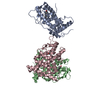

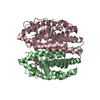
 Components
Components HOMO SAPIENS (human) / Cellular location: NUCLEUS / Plasmid: PET15 / Cellular location (production host): CYTOPLASM / Production host:
HOMO SAPIENS (human) / Cellular location: NUCLEUS / Plasmid: PET15 / Cellular location (production host): CYTOPLASM / Production host: 
 X-RAY DIFFRACTION / Number of used crystals: 1
X-RAY DIFFRACTION / Number of used crystals: 1  Sample preparation
Sample preparation SYNCHROTRON / Site:
SYNCHROTRON / Site:  ESRF
ESRF  / Type:
/ Type:  ESRF
ESRF  / Wavelength: 0.9
/ Wavelength: 0.9  Processing
Processing MOLECULAR REPLACEMENT / Resolution: 3.2→15 Å / Rfactor Rfree error: 0.007 / Data cutoff high absF: 2087323.51 / Isotropic thermal model: RESTRAINED / Cross valid method: THROUGHOUT / σ(F): 0
MOLECULAR REPLACEMENT / Resolution: 3.2→15 Å / Rfactor Rfree error: 0.007 / Data cutoff high absF: 2087323.51 / Isotropic thermal model: RESTRAINED / Cross valid method: THROUGHOUT / σ(F): 0  Movie
Movie Controller
Controller


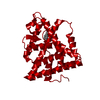
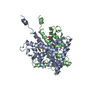

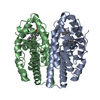




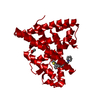
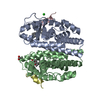


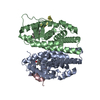



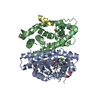


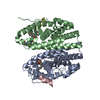

 PDBj
PDBj








